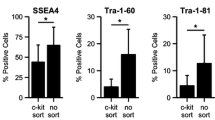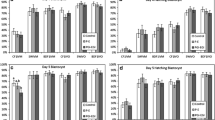Summary
Isolation and maintenance of porcine embryonic stem (pES) cells have been hindered by the inability to inhibit differentiation of the porcine inner cell mass (pICM) in vitro. Culture conditions currently in use have been developed from mouse ES cell culture and are not effective for maintaining the pICM. Optimizing culture conditions for the pICM is essential. We have developed a grading system to detect changes in the differentiation status of in vitro cultured pICM. Porcine ICMs (Day 7) were isolated by immunosurgery and cultured for 4 d in either Dulbecco’s modified Eagle’s medium (DMEM)-based medium (D medium) or DMEM/Ham’s F-10 (1:1)-based medium (D/H medium) with or without human Leukemia Inhibitory Factor (hLIF, 1000 iu/ml). Colonies were photographed daily for morphological analysis. pICMs were categorized into one of two types based on their morphological profile: type A, nonepithelial or type B, epithelial-like. Eight investigators evaluated pICM differentiation using standardized differentiation profiles. Each pICM series was graded on a scale of 1 (fully undifferentiated) to 5 (fully differentiated) for each time point. Differentiation was verified by alkaline phosphatase activity, cytokeratin staining, and scanning electron microscopy. Neither hLIF nor culture medium delayed differentiation of pICMs (P=0.08 and P=0.25, respectively). The grading system employed was an effective tool for detecting treatment effects on differentiation of the developing pICM. These results demonstrate that hLIF cannot significantly inhibit differentiation of the pICM, and is unlikely to assist in porcine ES cell isolation. Future experiments utilizing homologous cytokines may prove more beneficial.
Similar content being viewed by others
References
Anderson, G. B.; Choi, S. J.; BonDurant, R. H. Survival of porcine inner cell masses in culture and after injection into blastocysts. Theriogenology 42:204–212; 1994.
Borgers, M. The cytochemical application of new potent inhibitors of alkaline phosphatases. J. Histochem. Cytochem. 21:812–824; 1973.
Bradley, A.; Evans, M.; Kaufman, M. H., et al. Formation of germ-line chimaeras from embryo-derived teratocarcinoma cell lines. Nature 309:255–256; 1984.
Dawes, C. J. Biological techniques for transmission and scanning electron microscopy. Burlington, VT: Ladd Research Industries, Inc.; 1984.
Doetschman, T. C.; Eistetter, H.; Katz, M., et al. The in vitro development of blastocyst-derived embryonic stem cell lines: formation of visceral yolk sac, blood islands and myocardium. J. Embryol. Exp. Morphol. 87:27–45; 1985.
Doetschman, T.; Williams, P.; Maeda, N. Establishment of hamster blastocyst-derived embryonic stem (ES) cells. Dev. Biol. 127:224–227; 1988.
Donovan, P. J.; Stott, D.; Cairns, L. A., et al. Migratory and postmigratory mouse primordial germ cells behave differently in culture. Cell 44:831–838; 1986.
Evans, M. J.; Kaufman, M. H. Establishment in culture of pluripotential cells from mouse embryos. Nature 292:154–156; 1981.
Evans, M. J.; Notarianni, E.; Laurie, S., et al. Derivation and preliminary characterization of pluripotent cell lines from porcine and bovine blastocysts. Theriogenology 33:125–128; 1990.
Frohman, M. A.; Martin, G. R. Cut, paste and save: new approaches to altering specific genes in mice. Cell 56:145–147; 1989.
Gerfin, R. W.; Wheeler, M. B. Isolation of embryonic cell-lines from porcine blastocysts. Anim. Biotechnol. 6:1–14; 1995.
Giles, J. R.; Yang, X.; Mark, W., et al. Pluripotency of cultured rabbit inner cell mass cells detected by isozyme analysis and eye pigmentation of fetuses following injection into blastocysts or morulae. Mol. Reprod. Dev. 36:130–138; 1993.
Gough, N. M.; Williams, R. L.; Hilton, D. J., et al. LIF: a molecule with divergent actions on myeloid leukaemic cells and embryonic stem cells. Reprod. Fertil. Dev. 1:281–288; 1989.
Handyside, A.; Hooper, M. L.; Kaufman, M. H., et al. Towards the isolation of embryonal stem cell lines from the sheep. Roux’s Arch. Dev. Biol. 196:185–190; 1987.
Harlow, E.; Lane, D., Antibodies—a laboratory manual. Cold Spring Harbor, NY; Cold Spring Harbor Laboratory, 1988.
Iannaccone, P. M.; Taborn, G. U.; Garton, R. L., et al. Pluripotent embryonic stem cells from the rat are capable of producing chimeras. Dev. Biol. 163:288–292; 1994.
Koller, B. H.; Smithies, O. Altering genes in animals by gene targeting. Annu. Rev. Immunol. 10:705–730; 1992.
Martin, G. R. Isolation of a pluripotent cell line from early mouse embryos cultured in medium conditioned by teratocarcinoma stem cells. Proc. Natl. Acad. Sci. USA 78:7634–7638; 1981.
Nichols, J.; Evans, E. P.; Smith, A. G. Establishment of germ-line-competent embryonic stem (ES) cells using differentiation inhibiting activity. Development 110:1341–1348; 1990.
Niemann, H.; Illera, M. J.; Dzuik, P. J. Developmental capacity, size and number of nuclei in pig embryos cultured in vitro. Anim. Reprod. Sci. 5:311–321; 1983.
Notarianni, E.; Laurie, S.; Moor, R. M., et al. Maintenance and differentiation in culture of pluripotential embryonic cell lines from pig blastocysts. J. Reprod. Fert. Suppl. 41:51–56; 1990.
Petters, R. M.; Wells, K. D. Culture of pig embryos. J. Reprod. Fertil. Suppl. 48:61–73; 1993.
Piedrahita, J. A.; Anderson, G. B.; BonDurant, R. H. Influence of feeder layer type on the efficiency of isolation of porcine embryo-derived cell lines. Theriogenology 34:865–877; 1990a.
Piedrahita, J. A.; Anderson, G. B.; BonDurant, R. H. On the isolation of embryonic stem cells: comparative behavior of murine, porcine and ovine embryos. Theriogenology 34:879–901; 1990b.
Piedrahita, J. A.; Guillespie, L.; Maeda, N. Establishing an embryonic stem (ES) cell system utilizing hamster embryos. Biol. Reprod. Suppl. 42:175 (abstract); 1990c.
Piedrahita, J. A.; Zhang, S. H.; Hagaman, J. R., et al. Generation of mice carrying a mutant apolipoprotein E gene inactivated by gene targeting in embryonic stem cells. Proc. Natl. Acad. Sci. USA 89:4471–4475; 1992.
Saito, S.; Strelchenko, N.; Niemann, H. Bovine embryonic stem cell-like cell lines cultured over several passages. Roux’s Arch. Dev. Biol. 201:134–141; 1992.
Sims, M.; First, N. L. Production of calves by transfer of nuclei from cultured inner cell mass cells. Proc. Natl. Acad. Sci. USA 90:6143–6147; 1993.
Smith, A. G.; Heath, J. K.; Donaldson, D. D., et al. Inhibition of pluripotential embryonic stem cell differentiation by purified polypeptides. Nature 336:688–690; 1988.
Smith, A. G.; Hooper, M. L. Buffalo rat liver cells produce a diffusible activity which inhibits the differentiation of murine embryonal carcinoma and embryonic stem cells. Dev. Biol. 121:1–9; 1987.
Soulter, D.; Knowles, B. B. Immunosurgery of the mouse blastocyst. Proc. Natl. Acad. Sci. USA 72:5099–5102; 1975.
Strelchenko, N.; Stice, S. Bovine embryonic pluripotent cell lines derived from morula stage embryos. Theriogenology 41:304 (abstract); 1994.
Strojek, R. M.; Reed, M. A.; Hoover, J. L., et al. A method for cultivating morphologically undifferentiated embryonic stem cells from porcine blastocysts. Theriogenology 33:901–913; 1990.
Sukoyan, M. A.; Vatolin, S. Y.; Golubitsa, A. N., et al. Embryonic stem cells derived from morulae, inner cell mass and blastocysts of mink: comparisons of their pluripotencies. Mol. Reprod. Dev. 36:148–158; 1993.
Talbot, N. C.; Rexroad, C. E.; Pursel, V. G., et al. Culturing the epiblast of the pig blastocyst. In Vitro Cell. Dev. Biol. 29A:543–554; 1993.
Talbot, N. C.; Rexroad, C. E.; Pursel, V. G., et al. Alkaline phosphatase staining of pig and sheep epiblast cells in culture. Mol. Reprod. Dev. 36:139–147; 1993.
Thomson, J. A.; Kalishman, J.; Golos, T. G., et al. Isolation of a primate embryonic stem cell line. Proc. Natl. Acad. Sci. USA 92:7844–7848; 1995.
Wiles, M. V.; Keller, G. Multiple hematopoietic lineages develop from embryonic stem (ES) cells in culture. Development 111:259–267; 1991.
Wiley, L. M.; Spindle, A. I.; Pedersen, R. A. Morphology of isolated mouse inner cell masses developing in vitro. Dev. Biol. 63:1–10; 1978.
Williams, R. L.; Hilton, D. J.; Pease, S., et al. Myeloid leukaemia inhibitory factor maintains the developmental potential of embryonic stem cells. Nature 336:684–687; 1988.
Author information
Authors and Affiliations
Rights and permissions
About this article
Cite this article
Moore, K., Piedrahita, J.A. The effects of human leukemia inhibitory factor (hLIF) and culture medium on in vitro differentiation of cultured porcine inner cell mass (pICM). In Vitro Cell.Dev.Biol.-Animal 33, 62–71 (1997). https://doi.org/10.1007/s11626-997-0023-4
Received:
Accepted:
Issue Date:
DOI: https://doi.org/10.1007/s11626-997-0023-4




